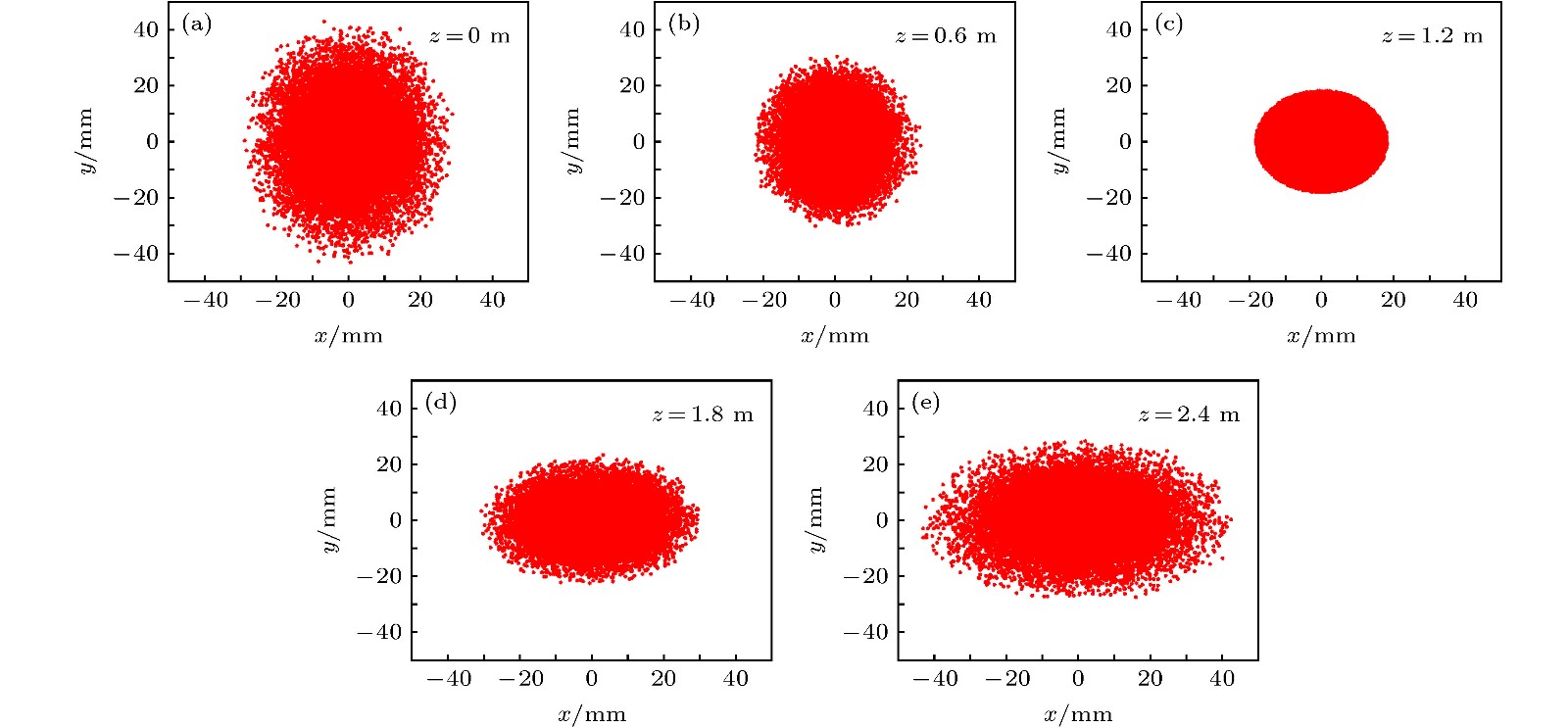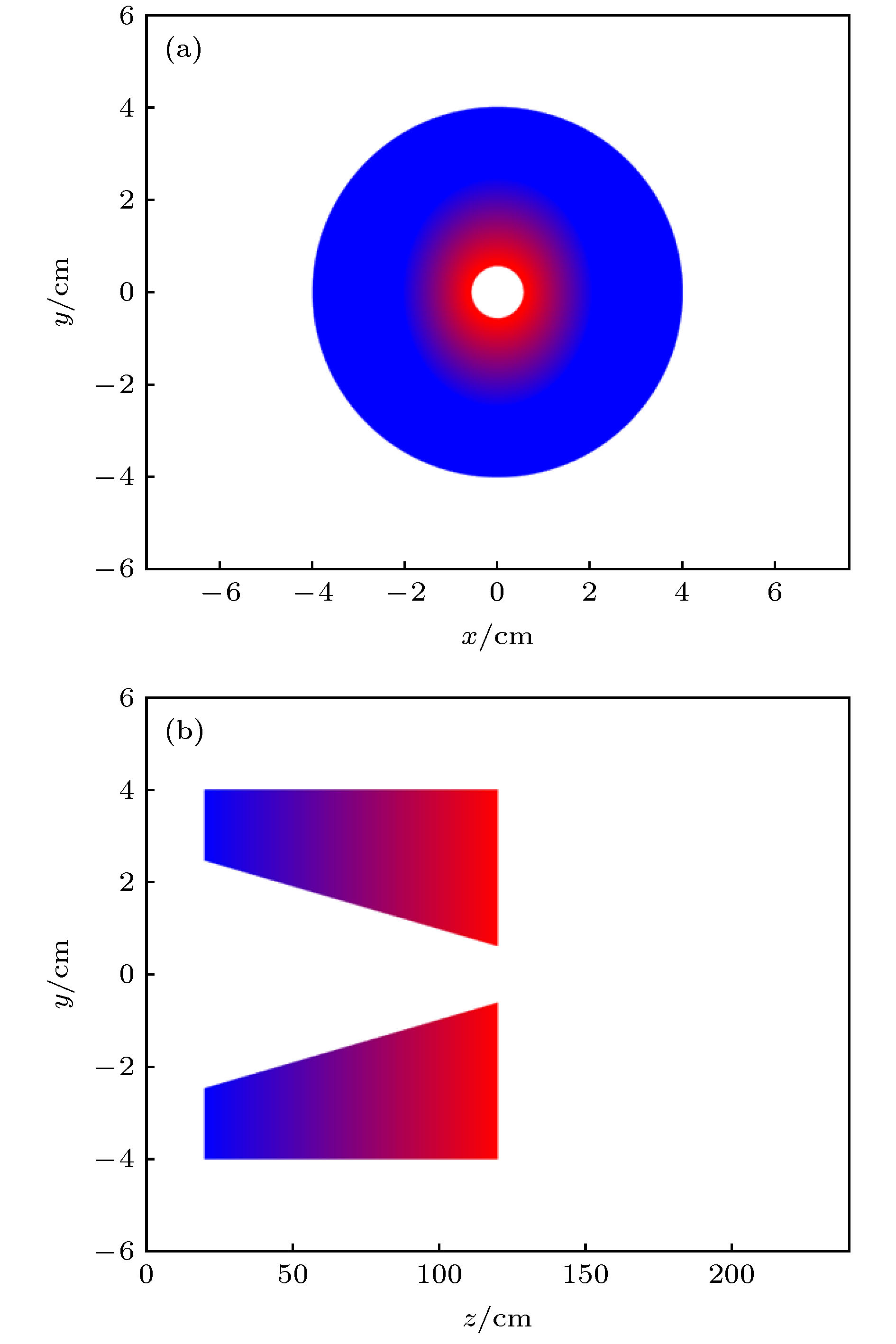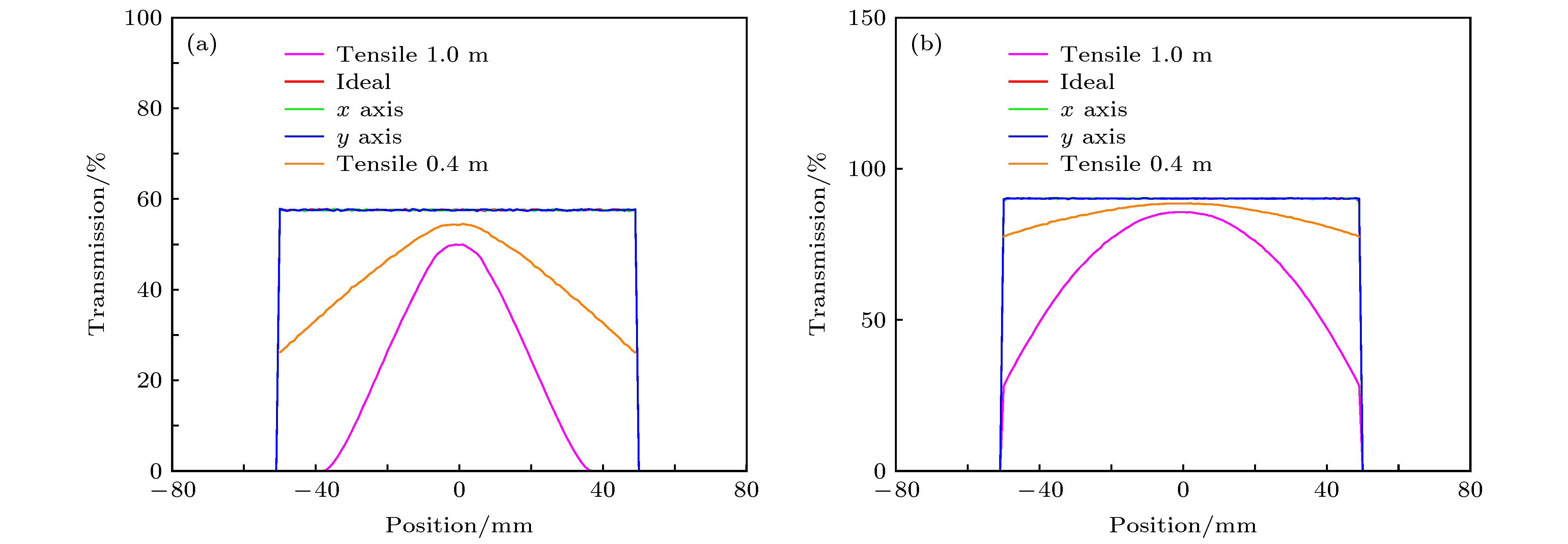-
The angle-cut collimator plays an important role in high-energy proton radiography. By using the collimator, the image contrast can be improved, and the material diagnosis and density reconstruction can be realized through secondary imaging. As all these techniques depend on the flux value, it is of great significance to reduce the error of the detected flux value. The ideal collimator is a much thin surface, but thick enough to block protons outside the collimation region. It is designed by stretching the aperture of the collimation plane. The shape is cylindrical, and it will increase the error of the flux value with the angle truncation. The initial bunch is defined and the phase diagram of the bunch within the angle-cut is ideal in the theoretical model. The equation of designing the collimator is given by theoretical analysis. It is given by the transfer matrix, the radius of the object and the angle-cut. The pore structure is oval-shaped by calculating and simulating. The proton imaging system of 1.6 GeV is established by Geant4 program, and the detector is ideal. The round copper plate and the concentric spheres are chosen as objects respectively. The parameters of the designed collimator is given by this method. The ideal collimator, tensile collimator and designed collimator are used in simulation, the radius of object is 5 cm and the angle-cut is 2 mrad and 3.5 mrad. The results show that when using the ideal and the designed angle-cut collimator, the flux distributions are in good agreement, while when using the tensile collimator, the result is quite different from that obtained by using the ideal collimator. Therefore, the collimator designed by this method can effectively reduce the error of the detected flux value.
-
Keywords:
- high-energy proton radiography /
- angle-cut collimator /
- density reconstruction /
- Geant4 code
[1] Gavton A, Morris C L, Ziock H J, et al. 1996 Los Alamos National Report 96 420
[2] Mottershead C T, Zumbro J D 1997 Proceedings of the 1997 Particle Accelerator Conference Vancouver B C, Canada, May 12–16, 1997 p1397
[3] Jason A J, Barlow D B, Blind B, Kelley J P, Lysenko W P, Neri F, Walstrom P L, Waynert J, Schulze M 2001 Proceedings of the 2001 Particle Accelerator Conference Chicago, USA, June 18–22, 2001 p3374
[4] King N S P, Ables E, Adams K, et al. 1999 Nucl. Instrum. Meth. Phys. Res., Sect. A 424 84
[5] Rigg P A, Schwartz C L, Hixson R S, Hogan G E, Kwiatkowski K K, Mariam F G, Marr-Lyon M, Merrill F E, Morris C L, Rightly P, Sauders A, Tupa D 2008 Phys. Rev. B 77 220101
 Google Scholar
Google Scholar
[6] Morris C L, Ables E, Alrick K R, et al. 2011 J. Appl. Phys. 109 104905
 Google Scholar
Google Scholar
[7] Antipov Y M, Afonin A G, Vasilevskii A V, et al. 2010 Instrum. Exp. Tech. 53 319
 Google Scholar
Google Scholar
[8] Golubev A A, Demidov V S, Demidova E V, Dudin S V, Kantsyrev A V, Kolesnikov S A, Mintsev V B, Smirnov G N, Turtikov V I, Utikin A V, Fortov V E, Sharkov B Y 2010 Tech. Phys. Lett. 36 177
 Google Scholar
Google Scholar
[9] Varentsov D, Antonov O, Bakhmutova A, et al. 2016 Rev. Sci. Instrum. 87 023303
 Google Scholar
Google Scholar
[10] Yang J J, Zhen X, Wei S M, Lv Y L, Wang F, Zhang Y W, Wen L P, Liu J Y, Cai H R, Ge T, Zhang S P, Cao L, Zhang T J, Li Z G 2016 CYC2016 Proceedings of the 21 st International Conference on Cyclotrons and their Applications Zurich, Switzerland, September 11–16, 2016 p401
[11] Merrill F E 2015 Rev. Accel. Sci. Technol. 8 165
 Google Scholar
Google Scholar
[12] Sheng L N, Zhao Y T, Yang G J, Wei T 2014 Laser Part. Beams 32 651
 Google Scholar
Google Scholar
[13] Wei T, Yang G J, Li Y D, et al. 2014 Chin. Phys. C 38 087003
 Google Scholar
Google Scholar
[14] Aufderheide M B, Park H, Hartouni E P 1999 AIP Conference Proceedings Sydney, Australia, June 28–July 2, 1999 p497
[15] Zumbro J D, Acuff A, Bull J S, et al. 2005 Radiat. Prot. Dosim. 117 447
[16] Fesseha G, Mariam, John P 2011 2011 High-Energy-Proton Microscopy Workshop Summary Report New Mexico, USA, October 27–28, 2011 p54
[17] Antipov Y M, Afonin A G, Gusev I A, et al. 2013 At. Energ. 114 359
 Google Scholar
Google Scholar
[18] Varentsov D, Bogdanov A, Demidov V S 2013 Phys. Medica 29 208
 Google Scholar
Google Scholar
[19] Yan Y, Sheng L N, Huang Z W, et al. 2015 Laser Part. Beams 33 439
 Google Scholar
Google Scholar
[20] Kantsyrev A V, Skoblyakov A V, Bogdanov A V 2018 J. Phys.: Conf. Ser. 946 012019
 Google Scholar
Google Scholar
[21] Agostinelli S, Allison J, Amako K A, et al. 2003 Nucl. Instrum. Meth. Phys. Res. Sect. A 506 250
 Google Scholar
Google Scholar
[22] Allison J, Amako K, Apostolakis J, et al. 2006 IEEE Trans. Nucl. Sci. 53 270
 Google Scholar
Google Scholar
-
表 1 1.6 GeV质子成像系统参数
Table 1. Parameters of the proton radiography system of 1.6 GeV.
s/m l/m G/T·m–1 t/m 1.2 0.8 8.09 0.5 表 2 准直器的孔径参数
Table 2. Aperture parameters of the collimator.
截断角/mrad 准直器类型 前端/cm 后端/cm 厚度/m 外半径/m 材料 x y x y 2 理想型 — 0.61 10–7 3 Al 拉伸型 0.61 0.61 1 & 0.4 3 W 设计型 2.04 2.46 0.61 1 3 W 3.5 理想型 — 1.07 10–7 3 Al 拉伸型 1.07 1.07 1 & 0.4 3 W 设计型 2.34 3.08 1.07 1 3 W -
[1] Gavton A, Morris C L, Ziock H J, et al. 1996 Los Alamos National Report 96 420
[2] Mottershead C T, Zumbro J D 1997 Proceedings of the 1997 Particle Accelerator Conference Vancouver B C, Canada, May 12–16, 1997 p1397
[3] Jason A J, Barlow D B, Blind B, Kelley J P, Lysenko W P, Neri F, Walstrom P L, Waynert J, Schulze M 2001 Proceedings of the 2001 Particle Accelerator Conference Chicago, USA, June 18–22, 2001 p3374
[4] King N S P, Ables E, Adams K, et al. 1999 Nucl. Instrum. Meth. Phys. Res., Sect. A 424 84
[5] Rigg P A, Schwartz C L, Hixson R S, Hogan G E, Kwiatkowski K K, Mariam F G, Marr-Lyon M, Merrill F E, Morris C L, Rightly P, Sauders A, Tupa D 2008 Phys. Rev. B 77 220101
 Google Scholar
Google Scholar
[6] Morris C L, Ables E, Alrick K R, et al. 2011 J. Appl. Phys. 109 104905
 Google Scholar
Google Scholar
[7] Antipov Y M, Afonin A G, Vasilevskii A V, et al. 2010 Instrum. Exp. Tech. 53 319
 Google Scholar
Google Scholar
[8] Golubev A A, Demidov V S, Demidova E V, Dudin S V, Kantsyrev A V, Kolesnikov S A, Mintsev V B, Smirnov G N, Turtikov V I, Utikin A V, Fortov V E, Sharkov B Y 2010 Tech. Phys. Lett. 36 177
 Google Scholar
Google Scholar
[9] Varentsov D, Antonov O, Bakhmutova A, et al. 2016 Rev. Sci. Instrum. 87 023303
 Google Scholar
Google Scholar
[10] Yang J J, Zhen X, Wei S M, Lv Y L, Wang F, Zhang Y W, Wen L P, Liu J Y, Cai H R, Ge T, Zhang S P, Cao L, Zhang T J, Li Z G 2016 CYC2016 Proceedings of the 21 st International Conference on Cyclotrons and their Applications Zurich, Switzerland, September 11–16, 2016 p401
[11] Merrill F E 2015 Rev. Accel. Sci. Technol. 8 165
 Google Scholar
Google Scholar
[12] Sheng L N, Zhao Y T, Yang G J, Wei T 2014 Laser Part. Beams 32 651
 Google Scholar
Google Scholar
[13] Wei T, Yang G J, Li Y D, et al. 2014 Chin. Phys. C 38 087003
 Google Scholar
Google Scholar
[14] Aufderheide M B, Park H, Hartouni E P 1999 AIP Conference Proceedings Sydney, Australia, June 28–July 2, 1999 p497
[15] Zumbro J D, Acuff A, Bull J S, et al. 2005 Radiat. Prot. Dosim. 117 447
[16] Fesseha G, Mariam, John P 2011 2011 High-Energy-Proton Microscopy Workshop Summary Report New Mexico, USA, October 27–28, 2011 p54
[17] Antipov Y M, Afonin A G, Gusev I A, et al. 2013 At. Energ. 114 359
 Google Scholar
Google Scholar
[18] Varentsov D, Bogdanov A, Demidov V S 2013 Phys. Medica 29 208
 Google Scholar
Google Scholar
[19] Yan Y, Sheng L N, Huang Z W, et al. 2015 Laser Part. Beams 33 439
 Google Scholar
Google Scholar
[20] Kantsyrev A V, Skoblyakov A V, Bogdanov A V 2018 J. Phys.: Conf. Ser. 946 012019
 Google Scholar
Google Scholar
[21] Agostinelli S, Allison J, Amako K A, et al. 2003 Nucl. Instrum. Meth. Phys. Res. Sect. A 506 250
 Google Scholar
Google Scholar
[22] Allison J, Amako K, Apostolakis J, et al. 2006 IEEE Trans. Nucl. Sci. 53 270
 Google Scholar
Google Scholar
Catalog
Metrics
- Abstract views: 13315
- PDF Downloads: 97
- Cited By: 0















 DownLoad:
DownLoad:












